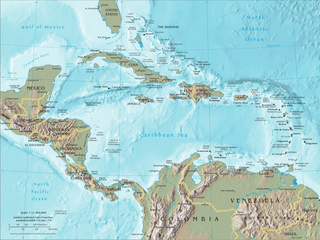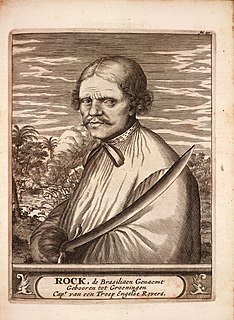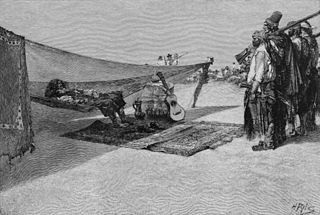Related Research Articles

Buccaneers were a kind of privateers or free sailors peculiar to the Caribbean Sea during the 17th and 18th centuries. First established on northern Hispaniola as early as 1625, their heyday was from the Restoration in 1660 until about 1688, during a time when governments were not strong enough and did not consistently attempt to suppress them.

Sir Henry Morgan was a Welsh privateer, plantation owner, and, later, Lieutenant Governor of Jamaica. From his base in Port Royal, Jamaica, he raided settlements and shipping on the Spanish Main, becoming wealthy as he did so. With the prize money from the raids he purchased three large sugar plantations on the island.

The era of piracy in the Caribbean began in the 1500s and phased out in the 1830s after the navies of the nations of Western Europe and North America with colonies in the Caribbean began combating pirates. The period during which pirates were most successful was from the 1660s to 1730s. Piracy flourished in the Caribbean because of the existence of pirate seaports such as Port Royal in Jamaica, Tortuga in Haiti, and Nassau in the Bahamas. Piracy in the Caribbean was part of a larger historical phenomenon of piracy, as it existed close to major trade and exploration routes in nearly all the five oceans.
Pirate havens are ports or harbors that are a safe place for pirates to repair their vessels, resupply, recruit, spend their plunder, avoid capture, and/or lie in wait for merchant ships to pass by. The areas have governments that are unable or unwilling to enforce maritime laws. This creates favorable conditions for piracy.

Tortuga Island is a Caribbean island that forms part of Haiti, off the northwest coast of Hispaniola. It constitutes the commune of Île de la Tortue in the Port-de-Paix arrondissement of the Nord-Ouest department of Haiti.

The Golden Age of Piracy is a common designation for the period between the 1650s and the 1730s, when maritime piracy was a significant factor in the histories of the Caribbean, the United Kingdom, Indian Ocean states, North America, and West Africa.

Roche Braziliano was a Dutch pirate born in the town of Groningen. His pirate career lasted from 1654 until his disappearance around 1671. He was first made famous in Alexandre Exquemelin's 1678 book The Buccaneers of America; Exquemelin did not know Braziliano's real name, but historians have found he was probably born as Gerrit Gerritszoon and that he and his parents moved to Dutch-controlled Brazil. He is known as "Roche Braziliano", which in English translates to "Rock the Brazilian", due to his long exile in Brazil.

Michel de Grammont was a French privateer. He was born in Paris, Kingdom of France and was lost at sea in the north-east Caribbean, April 1686. His privateer career lasted from around 1670 to 1686 during which he commanded the flagship Hardi. He primarily attacked Spanish holdings in Maracaibo, Gibraltar, Trujillo, La Guaira, Puerto Cabello, Cumana and Veracruz.

The Brethren or Brethren of the Coast were a loose coalition of pirates and privateers commonly known as buccaneers and active in the seventeenth and eighteenth centuries in the Atlantic Ocean, Caribbean Sea and Gulf of Mexico.
See also: list of 'years of Piracy'.
Laurens Prins, anglicized as Lawrence Prince, was a 17th-century Dutch buccaneer, privateer and an officer under Captain Sir Henry Morgan. He and Major John Morris led one of the columns against Panama in 1671.

Daniel Montbars (1645–1707?), better known as Montbars the Exterminator, was a 17th-century French buccaneer. For several years, he was known as one of the most violent buccaneers active against the Spanish during the mid-17th century. His reputation as a fierce enemy of the Spanish Empire was matched only by l'Ollonais and Roche Braziliano.

Edward Mansvelt or Mansfield was a 17th-century Dutch corsair and buccaneer who, at one time, was acknowledged as an informal chieftain of the "Brethren of the Coast". He was the first to organise large scale raids against Spanish settlements, tactics which would be utilised to attack Spanish strongholds by later buccaneers in future years, and held considerable influence in Tortuga and Port Royal. He was widely considered one of the finest buccaneers of his day and, following his death, his position was assumed by his protégé and vice-admiral, Henry Morgan.
Claes Gerritszoon Compaen, also called Claas Compaan or Klaas Kompaan, was a 17th-century Dutch corsair and merchant. Dissatisfied as a privateer for the Dutch Republic, he turned to piracy and captured hundreds of ships operating in Europe, the Mediterranean and West Africa during the 1620s.

Pierre le Picard (1624–1690?) was a 17th-century French buccaneer. He was both an officer to l'Olonnais as well as Sir Henry Morgan, most notably taking part in his raids at Maracaibo and Panama, and may have been one of the first buccaneers to raid shipping on both the Caribbean and Pacific coasts.
Jan Willems, also known as Janke or Yankey Willems, was a 17th-century Dutch buccaneer. Based out of Petit-Goâve, Willems participated in a number of expeditions against the Spanish during the early to mid-1680s with other well-known privateers including Michiel Andrieszoon, Thomas Paine, Laurens de Graaf, Nicholas van Hoorn and Michel de Grammont.
See also: 1705 in piracy, 1707 in piracy and the list of 'years of Piracy'.
Jan Erasmus Reyning (1640–1697) was a Dutch pirate, privateer and naval officer.
Thomas Freeman was an English buccaneer and pirate active in the Caribbean. He is best known for attacking the Spanish alongside Henry Morgan, David Marteen, and John Morris.
References
- ↑ Snelders, Stephen. The Devil's Anarchy. New York: Autonomedia, 2005. (pg. 84) ISBN 1-57027-161-5
- ↑ Konstam, Angus. Pirates: Predators of the Seas. New York: Skyhorse Publishing, 2007. (pg. 105) ISBN 1-60239-035-5
- ↑ Herman, Arthur. To Rule the Waves: How the British Navy Sharped the Modern World. New York: HarperCollins Publishers, 2004. (pg. 172) ISBN 0-06-053424-9
- ↑ Snelders, Stephen. The Devil's Anarchy. New York: Autonomedia, 2005. (pg. 6) ISBN 1-57027-161-5
- ↑ Leyland, John. The Yorkshire Coast and the Cleveland Hills and Dales. London: Seeley & Company, 1892. (pg. 212-213)
- ↑ Bennett, Martyn. The Civil Wars Experienced: Britain and Ireland, 1638–1661. London: Routledge, 2000. (pg. 155) ISBN 0-415-15901-6
- ↑ Port Royal
- ↑ Keegan, John and Andrew Wheatcroft. Who's Who in Military History: From 1453 to the present. New York: Routledge, 2002. (pg. 21) ISBN 0-415-12722-X
- ↑ Harris, Graham. Treasure and Intrigue: The Legacy of Captain Kidd. Toronto: Dundurn Press, 2002. (pg. 320) ISBN 1-55002-409-4
- ↑ Wilson, J. G.; Fiske, J., eds. (1900). . Appletons' Cyclopædia of American Biography . New York: D. Appleton.
- ↑ American Council of Learned Societies. Dictionary of American Biography, Vol. 8. New York: Scribner's Sons, 1959. (pg. 140)
- ↑ McCarthy, Kevin M. Twenty Florida Pirates. Sarasota, Florida: Pineapple Press, 1994. (pg. 35) ISBN 1-56164-050-6
